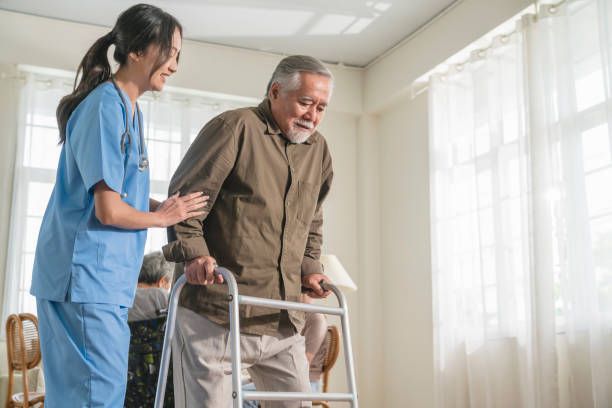Recovering from surgery can be particularly challenging for older adults, who often face a slower healing process, reduced mobility, and a higher risk of complications. For seniors, effective pain management is essential—not only to enhance comfort but also to prevent prolonged immobility, depression, or hospital readmission. Thankfully, a blend of modern and holistic therapy strategies can support post-surgical recovery in a safe and structured way. Here’s a look at how therapy can make a significant difference for seniors navigating post-surgical pain.
Contents
- 1 Understanding the Nature of Post-Surgical Pain in Seniors
- 2 Physical Therapy: Restoring Strength and Function
- 3 Occupational Therapy: Regaining Daily Independence
- 4 Pain Management Therapies: Beyond Medication
- 5 Aquatic Therapy: A Gentle but Powerful Option
- 6 Psychological Support and Counseling
- 7 Coordinated Care and Family Involvement
- 8 A Path Toward Resilient Recovery
Understanding the Nature of Post-Surgical Pain in Seniors
Post-surgical pain in seniors is not just a physical hurdle. It can be a multidimensional challenge that includes emotional distress, anxiety about recovery, and fear of movement. Age-related changes in muscle mass, joint flexibility, and metabolic processing of medications can all complicate recovery.
In many cases, seniors undergo procedures such as hip or knee replacements, cardiac surgeries, or spinal operations—all of which require thoughtful post-operative care. The goal of therapy is not just to reduce discomfort but to restore function, prevent complications such as blood clots, and enhance quality of life.
Physical Therapy: Restoring Strength and Function
Physical therapy (PT) remains the cornerstone of most post-operative recovery plans. Seniors recovering from orthopedic surgeries, such as joint replacements, particularly benefit from individualized PT programs designed to rebuild strength, flexibility, and balance.
Therapists often begin with passive movements or assisted exercises, progressing to weight-bearing and resistance-based training as tolerated. Tools like walkers, resistance bands, and balance boards are used to reintroduce safe movement. By focusing on core stability and joint alignment, PT helps prevent re-injury and promotes independence.
Equally important is education—therapists teach seniors how to move safely, transfer from bed to chair, and avoid falls. These lessons build confidence and reduce fear-driven immobility, a common barrier in older adults.
Occupational Therapy: Regaining Daily Independence

While physical therapy focuses on large-muscle movements and general mobility, occupational therapy (OT) zeroes in on day-to-day function. OT sessions help seniors relearn essential tasks such as dressing, bathing, preparing meals, or handling medication.
Occupational therapists may recommend adaptive tools—like grab bars, raised toilet seats, or reachers—to reduce strain and support healing. For seniors who live alone or have limited caregiving assistance, these interventions are critical.
Moreover, OT can address cognitive recovery if surgery involved anesthesia complications or affected cognitive clarity. Mental exercises and routine-building strategies ensure a holistic recovery that goes beyond physical pain.
Pain Management Therapies: Beyond Medication
While pain medication may be necessary in the immediate post-op period, long-term reliance—especially on opioids—is discouraged for older adults. Instead, therapy strategies emphasize drug-free approaches that can safely support pain control.
Heat and cold therapy can help reduce inflammation and stiffness. TENS units (transcutaneous electrical nerve stimulation) deliver low-voltage currents to painful areas and are frequently used in therapy clinics or prescribed for home use.
Massage therapy can also promote circulation and release tension around surgical areas. Even light-touch techniques have shown benefits for seniors by reducing stress hormones and promoting relaxation.
Guided imagery, breathing techniques, and mindfulness-based pain management are often introduced as cognitive tools that help seniors reframe their pain and reduce anxiety. These techniques are particularly effective when integrated with physical therapy for a mind-body recovery approach.
Aquatic Therapy: A Gentle but Powerful Option
Aquatic therapy—or water-based rehabilitation—is an increasingly popular strategy for post-surgical seniors. The buoyancy of water reduces pressure on joints, allowing movement with less pain and risk.
Heated therapy pools also improve circulation, relax muscles, and support range-of-motion exercises. Seniors recovering from joint surgery, spinal procedures, or mobility-related trauma often find aquatic therapy both soothing and empowering.
Sessions are typically guided by a trained therapist and may involve walking, stretching, or resistance exercises using water weights. The psychological boost of being able to move freely again cannot be understated.
Psychological Support and Counseling
Surgery can trigger emotional responses in seniors, including anxiety, depression, or post-traumatic stress. When pain is persistent or disabling, it can impact sleep, appetite, and emotional well-being.
Incorporating psychological therapy into the recovery plan is crucial. Cognitive-behavioral therapy (CBT) is often used to help seniors understand their pain, reframe negative thoughts, and develop coping strategies. Group therapy sessions or peer support groups can also reduce isolation and foster resilience.
For some seniors, especially those dealing with long hospital stays or life-altering surgeries, grief counseling may be appropriate to help them adjust to a new version of independence or function.
Coordinated Care and Family Involvement
Therapeutic success is often tied to a collaborative care model. Involving family members, caregivers, and a multidisciplinary team of therapists ensures consistency and motivation. Seniors are more likely to adhere to therapy plans when supported by people they trust.
Regular updates between physicians, physical therapists, and occupational therapists allow for adjustments in care as the patient progresses. Monitoring signs of overexertion, medication side effects, or new sources of pain is vital to prevent setbacks.
Family involvement also helps in understanding and meeting emotional needs—whether it’s transportation to therapy sessions, encouragement during exercises, or simply companionship during recovery.
A Path Toward Resilient Recovery
Managing post-surgical pain in seniors requires more than medication and rest. A thoughtful therapy plan that combines physical, occupational, psychological, and non-pharmacologic interventions gives seniors the best chance to recover fully and live independently.
By understanding and respecting the unique needs of aging bodies, caregivers and professionals can support a recovery journey that is both effective and compassionate. Therapy is not just about healing the body—it’s about restoring hope, confidence, and the freedom to move forward.
